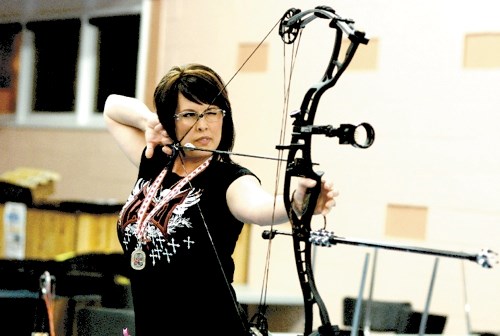The Battle River Archer's Club went to Lethbridge, Alta. Jan. 21 to 23, intent on winning and they didn't disappoint.
The Canadian National 3D indoor shoot challenges marksmen of all ages and skill levels across Canada, and two of the Battlefords' own found their aim to be true.
Tyson Mackrell won gold in the cadet category, while Raquel Hepp won gold in the ladies senior category.
Fifteen-year-old Tyson has been involved in archery for about four years.
"I always wanted to try hunting with a bow," he said. "I thought it was cool."
Targets aren't the only thing to come under the teenager's aim, he's taken his skill to the outdoors, and has brought down a bear, white tail, and an 82-inch antelope, believed to be the second-biggest antelope shot in Saskatchewan with a bow.
Tyson also excels in events, having set two Canadian records in the outdoor Canadian 900, a recognized FITA competition.
FITA, the International Archery Federation, derives its acronym from the French title, Fedération Internationale de Tir à L'Arc. The organization was founded in 1931 by seven countries and today comprises more than 140 national archery federations and associations.
In youth age classes, Canadian 900 competitors must shoot 30 arrows at 35 meters, 30 arrows at 45 meters and 30 arrows at 55 meters.
Tyson set the record for highest score at 55 meters and highest score overall.
He's also won a number of medals at various events.
"I bet you so many, he doesn't even remember how many anymore," said Ross MacAngus, long-time member and former president of the Battle River Archer's Club.
MacAngus said "naturals" at the sport are unlikely to last very long in the sport, whereas those who put the effort in are more likely to succeed.
"Tyson practices," he said. "Tyson works at it."
MacAngus also pointed out Tyson coaches the Junior Olympic Program every Tuesday, adding it likely helps Tyson pick out his own faults.
Although archery is a sport in the summer Olympics, it is FITA's World Championships that Tyson has his eyes set on.
"Olympics are only open to the recurve bow," he said, explaining he prefers shooting a compound bow.
Raquel Hepp, who is the current president of the club, had her start in archery about two and a half years ago when her husband bought her a bow.
"He thought I would love it, and I do," she said.
The Hepps, including their son and daughter, live on an acreage west of the Battlefords, and have made archery a family sport.
"That's why I enjoy it," said Hepp.
In last year's 3D, Hepp won silver in the ladies hunter category. This year, she moved up one category to win the gold in ladies senior.
"I went to get gold and I got it," she said. "I don't leave my family for any less!"
Next year, she also hopes to move up another category into open, which would have a number of perks.
"You can have all the bells and whistles on your bow," said Hepp.
Hepp also added she'll continue to enjoy С����Ƶ a member of the club because of the dedication of MacAngus.
"He's willing to lend a hand to anyone, at anytime," she said.
MacAngus has been a member of the Battle River Archer's Club for 37 years, and was president for over 10 years.
"It's something I never get bored with," he said.
MacAngus said he's enjoyed seeing the club climb from its dwindling membership to the current roster, which fluctuates between 70 to 100 members.
"We're the third biggest in the province," he said.
MacAngus said he believes the popularity of the sport can be credited to the relatively low cost of participating.
Yearly club fees are $50 for youth, $75 for adults and $125 for family, which includes membership in the Saskatchewan Archery Association, the Federation of Canadian Archers, insurance and a newsletter.
The club also has bows that beginners can use until they decide to buy their own.
The next event for the club is an outdoor 3D shoot at Mitchell's Farm, April 23 and 24, which is a qualifier for the Canadian Nationals.
The Battle River Archer's Club meets ever Monday and Thursday from 7 to 9 p.m. upstairs in the Civic Centre, and the Junior Olympic Program meets every Tuesday from 7 to 9 p.m. in the Wildlife Federation Building.




